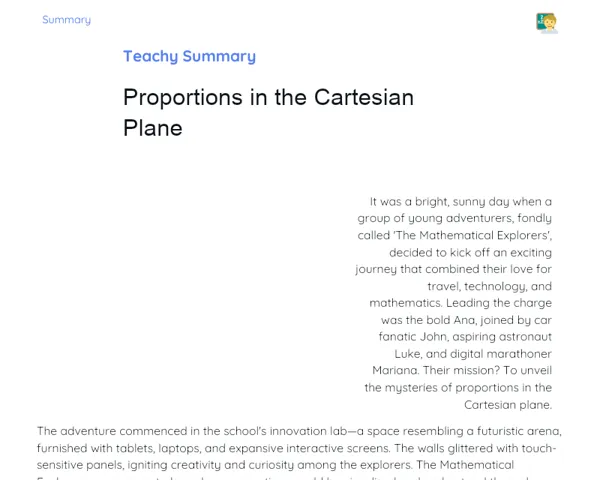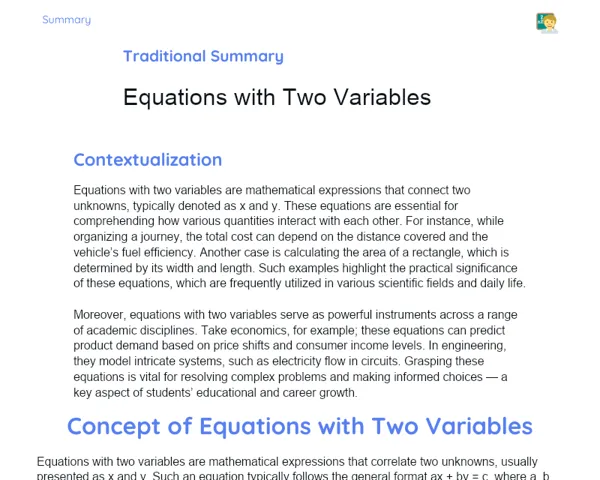Summary Tradisional | Conversion: Mass and Volume
Contextualization
Converting units of mass and volume is a handy skill, essential in our everyday activities and many professions. For instance, while cooking, following a recipe requires you to convert measurements accurately so that the dish turns out just right. In a school lab or a research centre, precise unit conversion plays a crucial role in measuring ingredients correctly and ensuring experiments are done properly.
Knowing how to convert mass units, for example, from grams to kilograms, and volume units, like from litres to cubic metres, is very important. Mass essentially measures how much matter is present, while volume measures the space an object occupies. These ideas come in handy when shopping for groceries or measuring the capacity of a container. Being comfortable with these conversions not only eases daily chores but also improves accuracy in all kinds of tasks.
To Remember!
Mass Unit Conversion
Mass unit conversion is a basic yet essential skill that lets us change measurements from one unit to another. The most common units you will encounter are the gram (g) and the kilogram (kg). One kilogram equals 1000 grams, so to change grams into kilograms, just divide the value by 1000. Similarly, to convert kilograms into grams, you simply multiply by 1000.
This conversion comes into play in many everyday situations. For example, when a recipe calls for an ingredient measured in grams, you might need to convert it into kilograms if that’s more convenient. In professional settings like laboratories, precision in mass measurement is vital for the success of experiments.
Furthermore, learning these conversions is an important part of our mathematics curriculum. It helps students understand the relationships between different units and sharpens their problem-solving abilities.
-
1 kilogram (kg) = 1000 grams (g)
-
To convert grams to kilograms, divide the value by 1000.
-
To convert kilograms to grams, multiply the value by 1000.
Volume Unit Conversion
Volume unit conversion is another important skill that allows us to change measurements from one unit to another. The most standard volume units are the litre (L) and the cubic metre (m³). One cubic metre is equivalent to 1000 litres, which means that to convert cubic metres to litres, you just multiply by 1000. Conversely, to convert litres to cubic metres, divide by 1000.
This technique is useful in everyday life – whether you are determining the amount of liquid in a bottle or calculating the capacity of a room for a building project. In academic subjects like chemistry and physics, mastering volume unit conversion helps students better grasp these concepts and apply them during experiments and calculations.
-
1 cubic metre (m³) = 1000 litres (L)
-
To convert cubic metres to litres, multiply by 1000.
-
To convert litres to cubic metres, divide by 1000.
Relationship Between Volume and Mass
Understanding the connection between volume and mass is very useful, and water provides a perfect example. One litre of pure water at 4°C has an exact mass of 1 kilogram. This means that, in this special case, the conversion from volume to mass is straightforward: 1 litre of water equals 1 kilogram.
This relationship is practical in daily life. When cooking, for instance, knowing that 1 litre of water weighs 1 kilogram can help you measure ingredients correctly without relying solely on a weighing scale. In scientific experiments, this simple relation helps in making quick and accurate measurements.
Grasping how volume and mass relate also aids students in developing an integrated understanding of measurement concepts, enabling them to solve problems more efficiently.
-
1 litre of pure water at 4°C = 1 kilogram (kg)
-
This relationship simplifies the conversion of volume to mass in practical scenarios.
-
Helps measure liquids accurately, sometimes even without a scale.
Practical Problem Solving
Solving real-life problems that involve unit conversions of mass and volume is an essential exercise. It allows students to put theoretical knowledge into practice. For example, when you need to convert 2500 grams to kilograms, just divide 2500 by 1000, which gives you 2.5 kilograms. Likewise, to convert 3 cubic metres to litres, multiply 3 by 1000 to get 3000 litres.
Regular practice not only helps students remember conversion rules but also builds their confidence in handling mathematical calculations. Moreover, these exercises improve logical reasoning and the ability to solve problems efficiently, which is useful both in academics and beyond.
-
Solving practical problems helps in applying theoretical knowledge effectively.
-
Examples include converting grams to kilograms and cubic metres to litres.
-
Enhances logical reasoning and overall problem-solving skills.
Key Terms
-
Gram (g): Unit of mass measurement.
-
Kilogram (kg): Unit of mass measurement, equivalent to 1000 grams.
-
Litre (L): Unit of volume measurement.
-
Cubic metre (m³): Unit of volume measurement, equivalent to 1000 litres.
-
International System of Units (SI): Globally accepted system of measurement units.
-
Unit Conversion: Process of transforming a measurement from one unit to another.
-
Mass: A measure of the amount of matter in an object.
-
Volume: Amount of space that an object occupies.
Important Conclusions
Converting units of mass and volume is a valuable skill that brings accuracy to both everyday tasks and professional activities. In our session, we looked at how to switch between grams and kilograms, as well as litres and cubic metres, and saw how these skills are practical, whether in the kitchen or in a science lab. We also examined the link between volume and mass through the example of water, showing how this simple relationship can make liquid measurements easier without always needing a scale.
The knowledge of mass and volume conversions not only strengthens mathematical skills but also builds the ability to tackle problems efficiently. Regular practice in these areas helps students internalise the conversion rules and develop confidence in their abilities, which can be very useful in both academic and daily life situations.
We highly encourage everyone to apply these techniques in daily activities and keep exploring the subject further. Mastering these conversions is not just important for exams but can also open up many opportunities in various academic and professional fields.
Study Tips
-
Practice converting mass and volume units during everyday tasks, such as while following a recipe or measuring liquids at home.
-
Solve extra unit conversion exercises to boost your understanding and gain confidence in using the formulas.
-
Review and explore the relationship between different measurement units to better visualise concepts and solve problems more efficiently.



